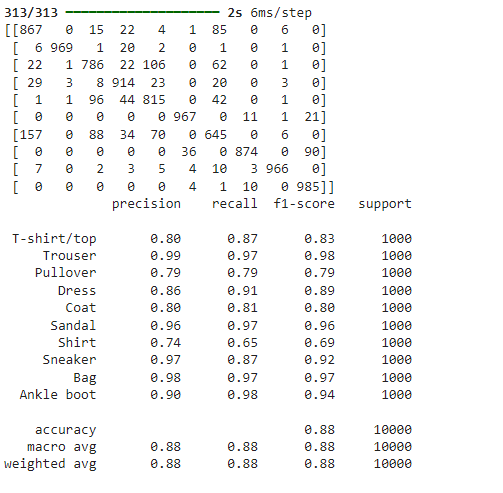Here well will build Fashion MNIST ANN Classification Model that is basically image classification task.
Image Classification with ANN Using Fashion MNIST Dataset
Objective
To construct an artificial neural network that can categorize pictures of clothing—such as t-shirts, pants, and shoes—into pre-established groups.
Dataset Info:

Import the required Libraries
import numpy as np
import matplotlib.pyplot as plt
import tensorflow as tf
from tensorflow.keras.models import Sequential
from tensorflow.keras.layers import Dense, Flatten
from sklearn.metrics import classification_report, confusion_matrix
Load and Preprocess the dataset
fashion_mnist_dataset = tf.keras.datasets.fashion_mnist
(X_train, y_train), (X_test, y_test) = fashion_mnist_dataset.load_data()Normalize the pixel values (Images) to be between 0 and 1
X_train = X_train / 255.0
X_test = X_test / 255.0Exploratory Data Analysis
Plot the first 10 images in the training dataset
# Plot the first 10 images in the training dataset
plt.figure(figsize=(10,10))
for i in range(10):
plt.subplot(2, 5, i+1)
plt.xticks([])
plt.yticks([])
plt.grid(False)
plt.imshow(X_train[i], cmap=plt.cm.binary)
plt.xlabel(f'Label: {y_train[i]}')
plt.show()
Each image corresponds to a clothing category with a label (0–9), which we will map as follows:
- 0 = T-shirt/top
- 1 = Trouser
- 2 = Pullover
- 3 = Dress
- 4 = Coat
- 5 = Sandal
- 6 = Shirt
- 7 = Sneaker
- 8 = Bag
- 9 = Ankle boot
Distribution of Classes
# Distribution of the labels in the training dataset
unique, counts = np.unique(y_train, return_counts=True)
class_distribution = dict(zip(unique, counts))
print("Class Distribution: ", class_distribution)Class Distribution: {0: 6000, 1: 6000, 2: 6000, 3: 6000, 4: 6000, 5: 6000, 6: 6000, 7: 6000, 8: 6000, 9: 6000}
Build the Artificial Neural Network (ANN) model
# Initialize the model
model = Sequential()
# Flatten the 28x28 images into a 1D array (28*28 = 784)
model.add(Flatten(input_shape=(28, 28)))
# Add hidden layers with ReLU activation
model.add(Dense(units=128, activation='relu'))
model.add(Dense(units=64, activation='relu'))
# Output layer with 10 units for the 10 classes, using softmax activation
model.add(Dense(units=10, activation='softmax'))
# Compile the model
model.compile(optimizer='adam', loss='sparse_categorical_crossentropy',
metrics=['accuracy'])
# Model summary
model.summary()

Model training
# Train the model
history = model.fit(X_train, y_train, validation_split=0.2, epochs=10,
batch_size=32)

Model Evaluation
# Plot accuracy and loss over epochs
plt.figure(figsize=(12, 4))
# Accuracy plot
plt.subplot(1, 2, 1)
plt.plot(history.history['accuracy'], label='train accuracy')
plt.plot(history.history['val_accuracy'], label='val accuracy')
plt.title('Model Accuracy')
plt.xlabel('Epochs')
plt.ylabel('Accuracy')
plt.legend()
# Loss plot
plt.subplot(1, 2, 2)
plt.plot(history.history['loss'], label='train loss')
plt.plot(history.history['val_loss'], label='val loss')
plt.title('Model Loss')
plt.xlabel('Epochs')
plt.ylabel('Loss')
plt.legend()
plt.show()

Check model performance on Test data
# Evaluate the model on the test data
test_loss, test_accuracy = model.evaluate(X_test, y_test)
print(f"Test Accuracy: {test_accuracy * 100:.2f}%")

Confusion Matrix and Classification Report
# Predict the labels for the test set
y_pred = np.argmax(model.predict(X_test), axis=1)
# Confusion matrix
conf_matrix = confusion_matrix(y_test, y_pred)
print(conf_matrix)
# Classification report
print(classification_report(y_test, y_pred, target_names=[
'T-shirt/top', 'Trouser', 'Pullover', 'Dress', 'Coat',
'Sandal', 'Shirt', 'Sneaker', 'Bag', 'Ankle boot']))

Save the Model for deployment
# Save the model in H5 format
model.save('fashion_mnist_ann_model.h5')
Conclusion
In this project, we were able to construct an Artificial Neural Network (ANN) that can reasonably identify Fashion MNIST photos. Although there was still some confusion between identical clothing items, the model performed well. In fact, Convolutional Neural Networks may be employed in the future for better recognition of images. On the whole, this work shows the effectiveness of deep learning for problems associated with image classification.